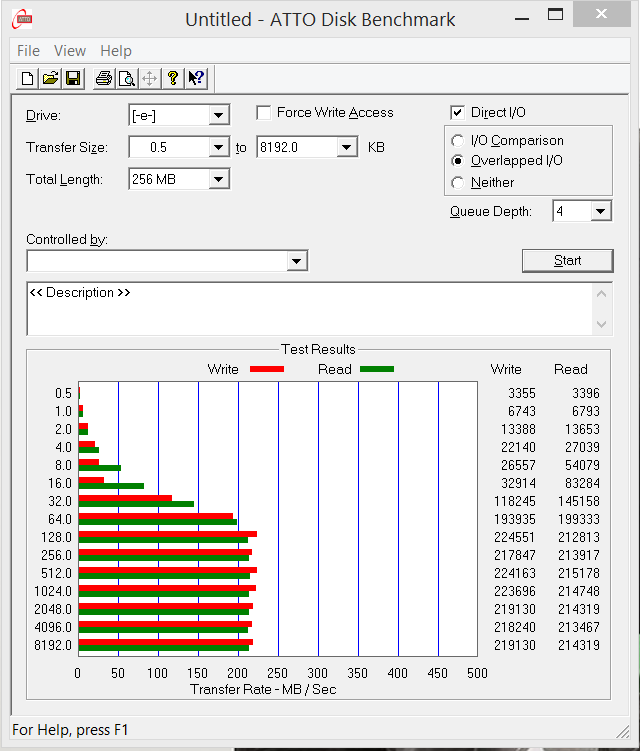ATTO Disk Benchmark is perhaps one of the oldest benchmarks going and is definitely the main staple for manufacturer performance specifications. ATTO uses RAW or compressible data and, for our benchmarks, we use a set length of 256mb and test both the read and write performance of various transfer sizes ranging from 0.5 to 8192kb. Manufacturers prefer this method of testing as it deals with raw (compressible) data rather than random (includes incompressible data) which, although more realistic, results in lower performance results.
High sequential read and write speeds of 214MB/s and 224MB/s are close to and above listed specifications. If you take a close look at this benchmark, you may notice that, unlike what we see in SSDs,we aren’t reaching higher performance until the 64GB file size. This is typical of all flash drives as their purpose is best suited for the movement and storage of large files. Comparing this to the SSD, we might see SATA 3 transfer speeds starting around the 4K mark; this being necessary in order to move and execute operating system files as quick as possible.
CRYSTAL DISK BENCHMARK VER. 3.0 X64
Crystal Disk Benchmark is used to measure read and write performance through sampling of random data which is, for the most part, incompressible. Performance is virtually identical, regardless of data sample so we have included only that using random data samples.
Testing in CDM and using 100% incompressible (or random) data samples shows us just how solid the Mach Xtreme MX-ES Ultra flash drive really is, as high sequential write performance is actually stronger than read performance. This is something we don’t often see in flash drives, especially those not using premium synchronous or toggle mode NAND flash memory.
The toughest benchmark available for solid state drives is AS SSD as it relies solely on incompressible data samples when testing performance. For the most part, AS SSD tests can be considered the ‘worst case scenario’ in obtaining data transfer speeds and many enthusiasts like AS SSD for their needs. Transfer speeds are displayed on the left with IOPS results on the right.
You won’t often see reviewers using AS SSD as a benchmark with flash drives because complete 4K and 4K-64Thrd tests takes excruciating long. WE thought it important to get the high sequential tests in to demonstrate once again hoe fast this SSD can transfer large files.
ANVIL STORAGE UTILITIES PROFESSIONAL
Anvil’s Storage Utilities (ASU) are the most complete test bed available for the solid state drive today. The benchmark displays test results for, not only throughput but also, IOPS and Disk Access Times. Not only does it have a preset SSD benchmark, but also, it has included such things as endurance testing and threaded I/O read, write and mixed tests, all of which are very simple to understand and use in our benchmark testing.
Last but not least, we have included Anvil Storage Utilities as it does give us a close look at those very low 4K results without taking an hour to complete. Conversely, it also gives us our first look at IOPS. Once again, we think the great takeaway here is the mark of consistency we see in the high transfer speed results.
 The SSD Review The Worlds Dedicated SSD Education and Review Resource |
The SSD Review The Worlds Dedicated SSD Education and Review Resource | 


Wow, those writes (atleast for a 64GB device) are insane… Random 4K on the other hand…
Interesting review ! SLC flash drives are indeed extremely rare beasts, there is one other company that also made some SLC flash drives – Transcend .They were listed in product leaflets recently (maybe 2 years ago) ….
Price wise this flash drive is very attractive for SLC , I remember paying around $130 for a chunky light gold colored 8GB Transcend Jetflash flash drive with SLC 6 years ago 🙂
I wonder if they are using an actual SLC flash or just 128GB of MLC and then simulated to SLC…
From Mach Xtreme:
The MX-ES USB3.0 Series utilizes hand-selected top performance Single Level Cell (SLC) NAND to offer extreme performance and endurance over Multi-Level Cell (MLC) NAND, which is typically used in other USB3.0 pendrives. Changing the NAND components from MLC to SLC significantly increases the performance and longevity of MX-ES Ultra flash drive.
These USB3.0 flash pendrives are much more durable and reliable and are built to endure severe operating environments such as extreme cold and hot temperatures, continuous vibration, high shock impact, intensive read-write cycles etc. Such features are essential to users that require a more robust and rugged digital storage option to ensure repeatable and reliable operation. With selected, powerful SLC flash and proven design; the MX-ES Ultra Series drastically outperforms standard ES pendrives.